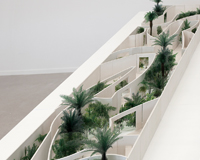Contact Center
.
11 January 2015
Bahrain Pavilion at the Expo Milano 2015 ahead of schedule


Manama, 5th January 2015 -Construction work at the Kingdom of Bahrain self-built pavilion in the Expo Milano 2015 has surpassed that of neighbouring pavilions with rough construction and all exteriors completed in the days leading up to the new year. The pavilion, entitled Archaeologies of Green, is built over an area of 2000sqm and is designed to raise awareness of Bahrain’s singular agricultural culture and heritage as well as the importance of sustainable development practices.
Of the fifty built national pavilions of other participating countries thus far, the Bahrain pavilion, which was designed by Dutch architect Anne Holtrop in collaboration with the landscape architect Anouk Vogel, is the first to be near completion despite the early start in actual building by other country pavilions and contractors.
‘We’re delighted to be participating this year in the Expo Milano 2015 with a novel pavilion design that supports our objectives to both raise awareness of our unique agricultural heritage and distinct tourism features,’ commented HE Shaikha Mai, the Bahrain Pavilion Commissioner General. ‘As a result, it’s doubly gratifying that our pavilion is the first amongst the 147 country participations to be completed,’ she added.
After building permission for the Bahrain pavilion, Archaeologies of Green, was granted by the Italian authorities in late July 2014, construction on site started in September last year. Italian contracting firm, Restaura SAL were originally scheduled to complete the construction of the pavilion by the end of March 2015. The pace of construction and rapid development of the Bahrain pavilion amongst other sites within the Expo grounds in Milan has attracted widespread interest with positive reviews in Italian media including the daily Corriere della Sera.
Themed "Feeding the Planet, Energy for Life," the Expo Milano 2015 opens on 1st May 2015 and is expected to welcome over 20 million visitors to the exhibitions and pavilions of its official participants. Expo Milano 2015 revolves around nutrition and sustainability, highlighting the importance of protecting the planet’s natural resources. The various national pavilions shed light on the diverse cultural characters of countries around the world, allowing visitors to sample traditional foods and learn more about the cultural attributes and agrarian heritages of different nations.
Commissioned by the Ministry of Culture, Archaeologies of Green is conceived as a continuous landscape of fruit gardens that each contain a dominant fruit tree that is native to Bahrain and are intersected by a series of closed spaces that contain in turn a reception area, exhibition spaces and a café serving local Bahraini food. The spaces all overlook and frame the gardens, which form the main exhibition component of the pavilion and recount the rich agrarian heritage of the Islands.







